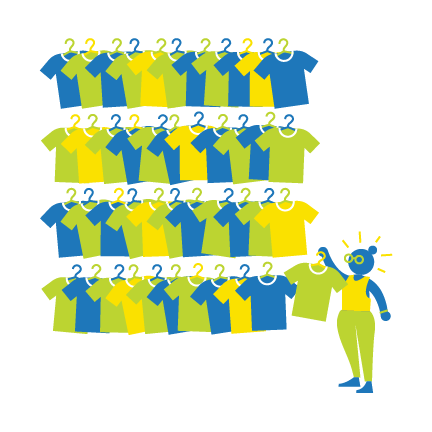In the grand scheme of things, is the shirt on your back really that big of a deal?
Well, yes.

Clothing is one of the fastest growing waste streams in Metro Vancouver, which encompasses 21 municipalities, one electoral area and one treaty First Nation. A whopping 20,000 tonnes of clothing waste is created in the region every year, in large part because of fast fashion and short trend cycles. That’s about 8kg of clothing, roughly the equivalent of 44 t-shirts, discarded every year, per person.
There’s good news here though: we can reduce that number. And shifting to a circular economy Circular EconomyA circular economy is basically a recycling superhero of the business world. It's all about keeping products and resources in a never-ending loop of usefulness instead of letting things go to waste. It's smart, sustainable, and takes a heck of a lot of creativity. when it comes to clothes shopping is a relatively simple way to do so.
“Any action that keeps an item in circulation—whether it’s repairing it or reusing it or turning it something into something else entirely—contributes to a circular economy,” says Sarah Tulga, Science World Climate Education Specialist.
A great place to start is with things that are already in circulation, says Sam Rayner, co-founder of BC-based home- and personal-care brand Better Basics.
“Wherever possible, I try to give something a second life by buying pre-loved or consignment,” says Rayner. “I try to choose natural materials like cotton, wool and linen, whenever I can, because they’re often going to be of a higher quality and they don’t shed microplastics, like synthetic materials do.
“Then I try to extend the life of the pieces I have.”
When it comes to clothes, she says that means being particular about how—and how often—we do laundry.
“Washing machines and dryers are designed for efficiency, not for preserving the longevity of our clothes,” Rayner says. “They can wear out our clothes quite quickly so if I had the time and the space, I would handwash and hang dry. I spot clean whenever possible and try to make sure I only run a load only when it’s full to avoid creating excess water waste. I run a cold cycle because that uses less energy.”
If our aim is to extend the life of things we already own—and keep them in good enough shape to pass along to the next person—caring for them is key. And for help with that, we can look to chemistry to answer the question: How do we keep our clothes spotless?
“There are basically three ways of doing it, depending on what type of stain you’re dealing with,” says Dr. Nabyl Merbouh, Teaching Professor of Chemistry at SFU. If you have an organic stain like from blood or grass for example, he says an enzymatic stain remover will be the most effective way to break it down. Those are the stain removers you typically think of—the sprays and the sticks.
Then there are stains with synthetics or natural dyes in them.
“Synthetic or natural colours come from polyconjugated systems called chromophores,” Dr. Merbouh says. “Which means the molecules are made of alternating single and double bonds systems. These conjugated systems absorb light, and are responsible for the colour of the molecules.” To get at those types of stains, Dr. Merbouh says, you need to break down the chemical structure that is absorbing the light (chromophore). Bleach or peroxides are the most effective way to do so.

